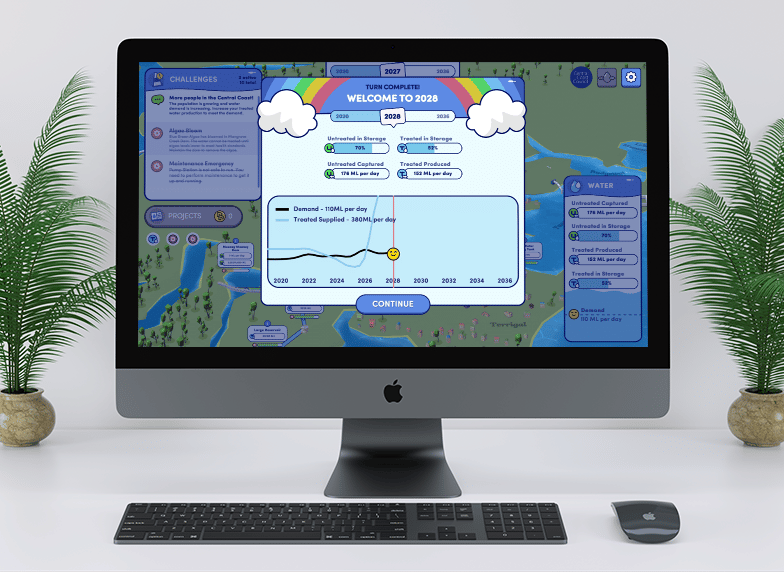Gamification Definition
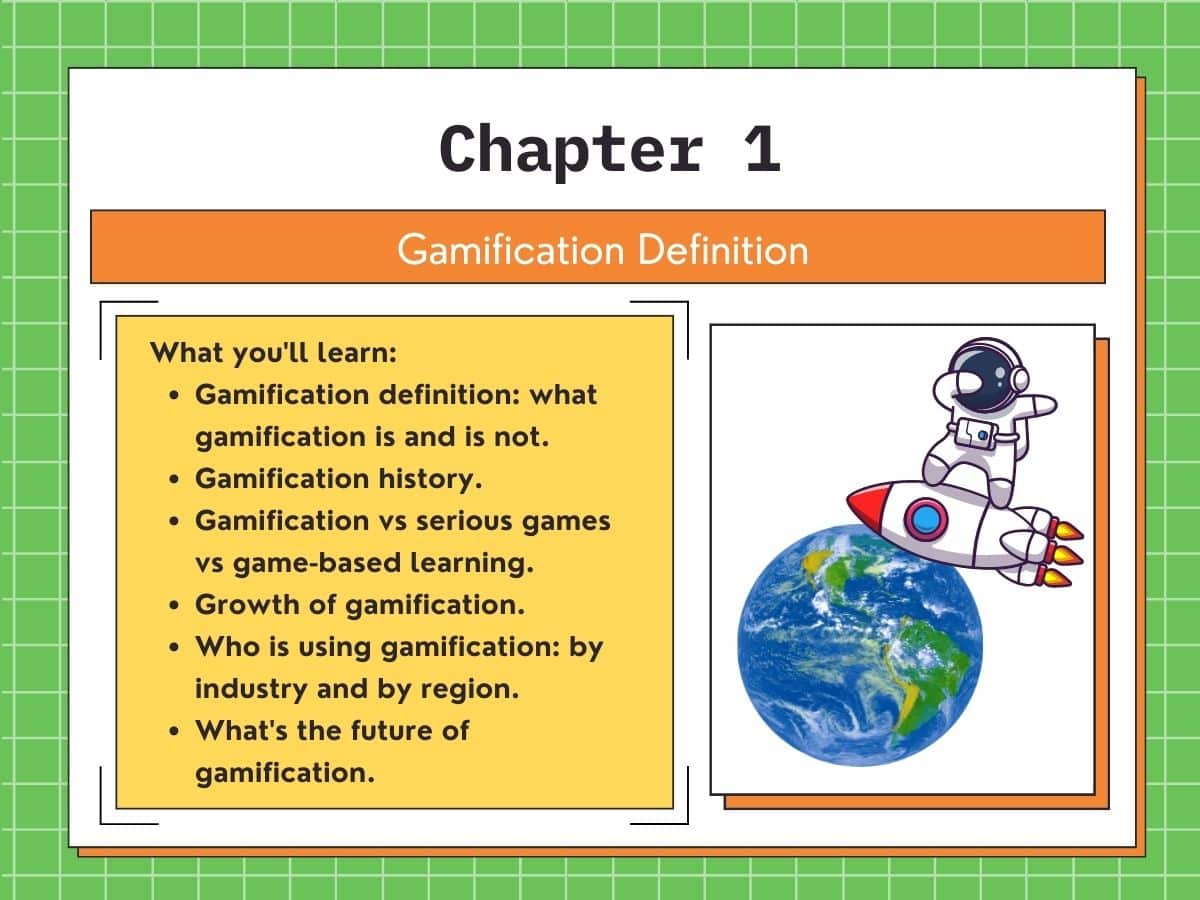
What is the definition of gamification? Having a deep understanding of gamification is crucial if you are planning to engage users online.
After all, it’s hard to grow in something when you don’t know how it works.
In this chapter, we’ll talk about gamification definition, history, growth by region and industry as well as its future. We’ll also make clear the difference between gamification, serious games and game-based learning. Fasten your seat belt.

What is gamification? When people talk about gamification, they usually define it like this:
Gamification is the use of game elements, mechanics and design techniques in non-game scenarios to motivate people.
Gamification is the use of game elements, mechanics and design techniques in non-game scenarios to motivate people.
While there is a lot of jargon in this definition, it’s not something you need to worry about right now. We’ll explain what game mechanics, game design and game elements are later on. Before we talk about what gamification is, maybe we should start with what it is not. That way, you’ll have a clear foundation for our future-focused projections.
What Gamification is not?
#1. Gamification is NOT the same as a game
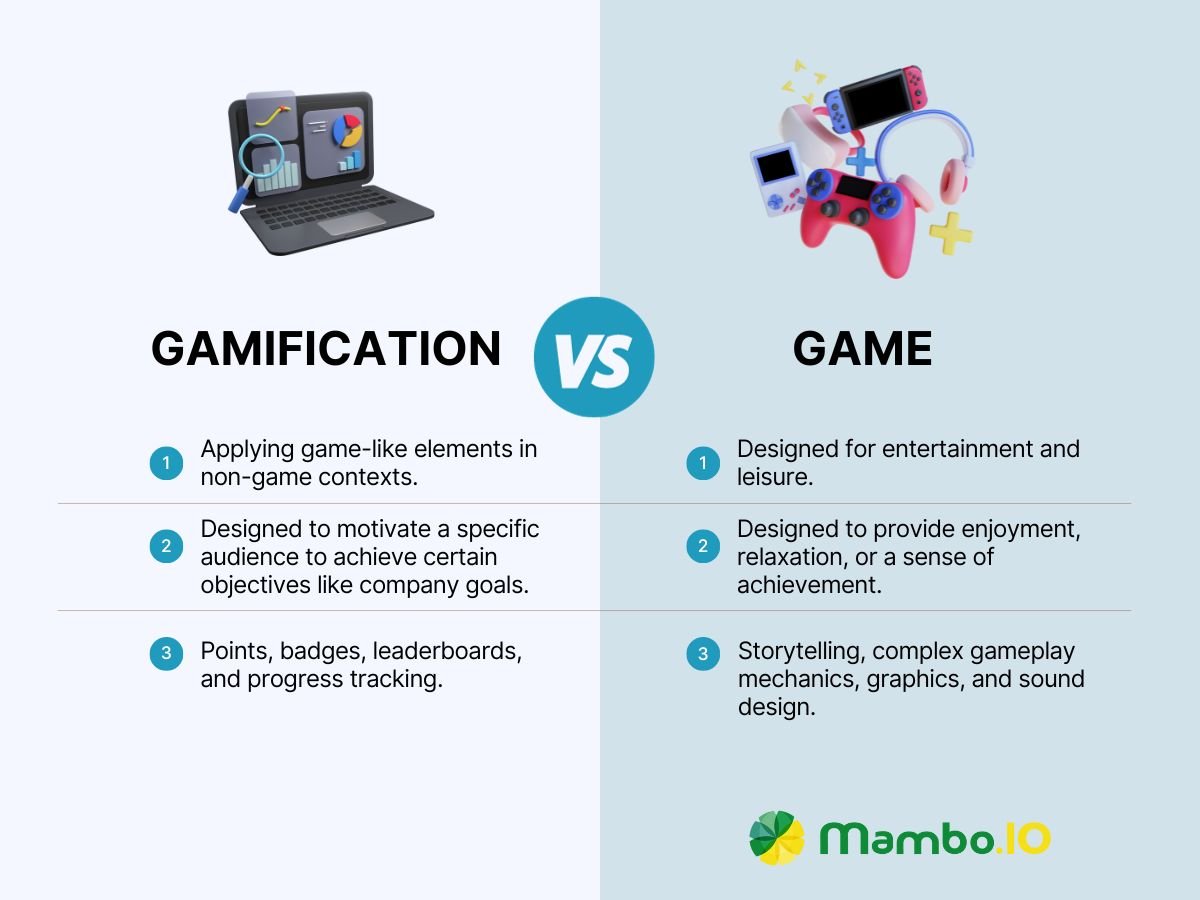
No, you’re not making the next Tetris or Call of Duty.
Gamification doesn’t take your intervention and make it into a real game. That’s because games entertain. They don’t do anything else by design. Sure, you might play Fortnite and learn about teamwork, but that’s not its purpose.
When you use gamification, you’re tapping into intrinsic and extrinsic motivations. These could be getting rewards, competing, achievement and the like. And while gamification can be fun, that’s not the core focus. You’re trying to drive behaviour, educate, change minds or explain new concepts. Gamification is a business goal plus fun to spur action.
So, you do that with game mechanics. You make real-world tasks more immersive and entertaining. How that happens is based on your company ethos, processes and goals. Whatever you implement must work for the real people within your organisation.
What works for an artist might seem uncouth for a nurse. Ideally, your gamification needs to be designed for the people who will use it – psychologically and behaviourally.
#2. Gamification is not a simulation

When you make a simulation, you put the player into an environment. Gamification puts a game environment into the business world.
It’s like the reverse. You use simulations to implement models. A simulation can be live, virtual or constructive. Those are the core 3 types of a simulated game.
First, a live simulation uses real systems and real people to mimic the actual activity. It might even use the real equipment in the real environment just under mock circumstances.
Then you have virtual. This is real people using fake tools – think pilot simulators. Lastly, you can use constructive simulations. This is where fake people use fake systems and real people just influence what happens. You’ll find this model is great for making predictions, measurements, analysing concepts and the like.
But because simulators usually don’t use gamification techniques, what starts as fun usually gets boring fast.
Overall, it’s because gamification motivates users. It uses game elements to deliver a challenge or competition – even more so if there is a reward involved. Simulators are usually missing the leaderboards, badges, rewards and healthy competition amongst players.
However, if you have a simulation, you can add gamification elements to it to boost engagement with users. Think about a flying simulator that links up to a global leaderboard. Such gamification integration would encourage pilots to improve themselves across core metrics like time, safety and precision.
#3. Gamification isn’t a theory
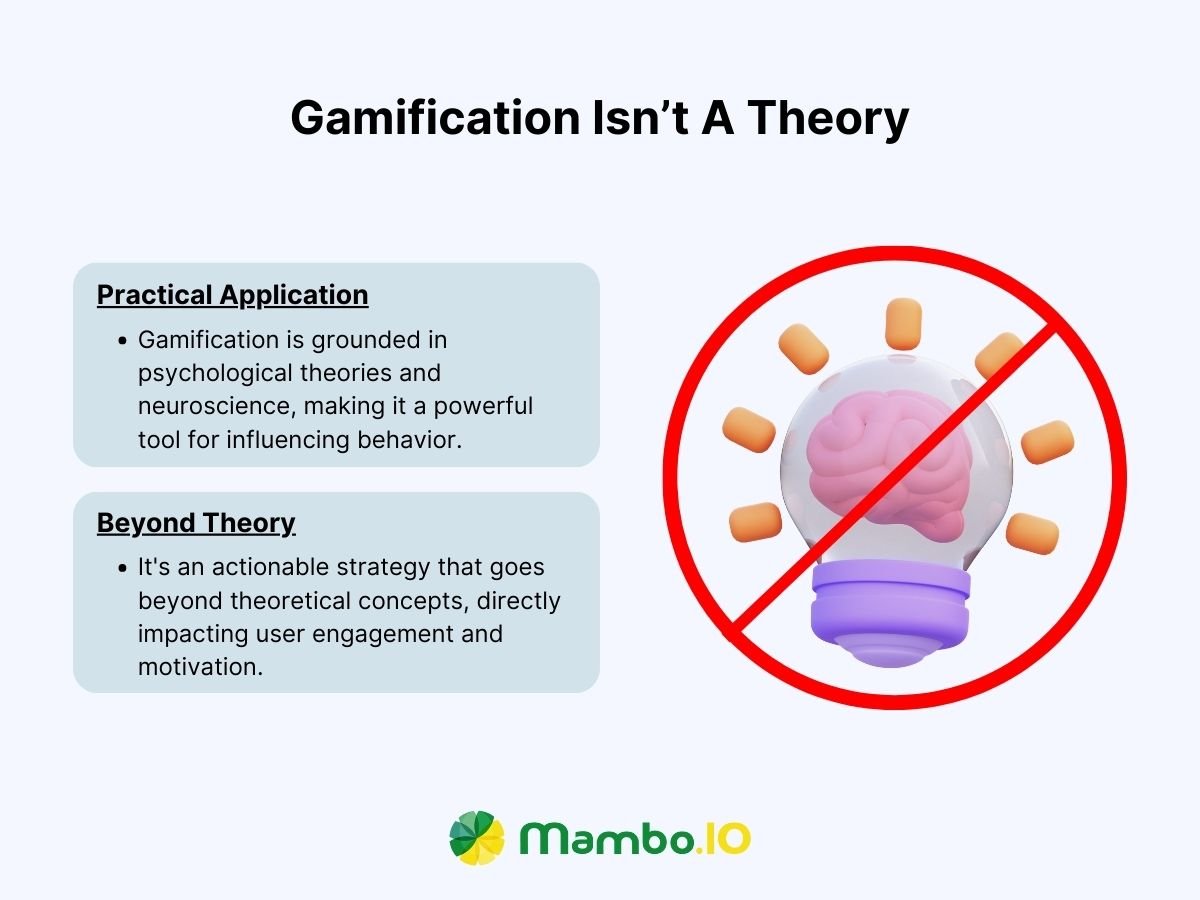
Well, that’s just false. Just look to Brian Burke’s exploration into Autonomy, Mastery and Purpose in the 2014 book, “Gamify: How Gamification Motivates People to Do Extraordinary Things.” He discusses how gamification triggers internal rewards to such a degree external motivators fall by the wayside. And intrinsic motivators have a deeper correlation to core human needs like validation and self-actualisation.
Not convinced?
Look at the PERMA model from psychologist Martin Seligman. Gamification triggers more positive psychological states and not only does that impact how they view an activity but also how engaged and inspired they are.
There are many more theories, from Vroom’s Theory of Expectancy to Alderfer’s ERG Theory, which we’ll cover in the next few chapters. Just know that the neuroscience behind rewarding brain chemicals is closely linked with successful gamification triggers. In short, they’re what fuels behavioural change and desired actions.
#4. Gamification is NOT only for the younger generation
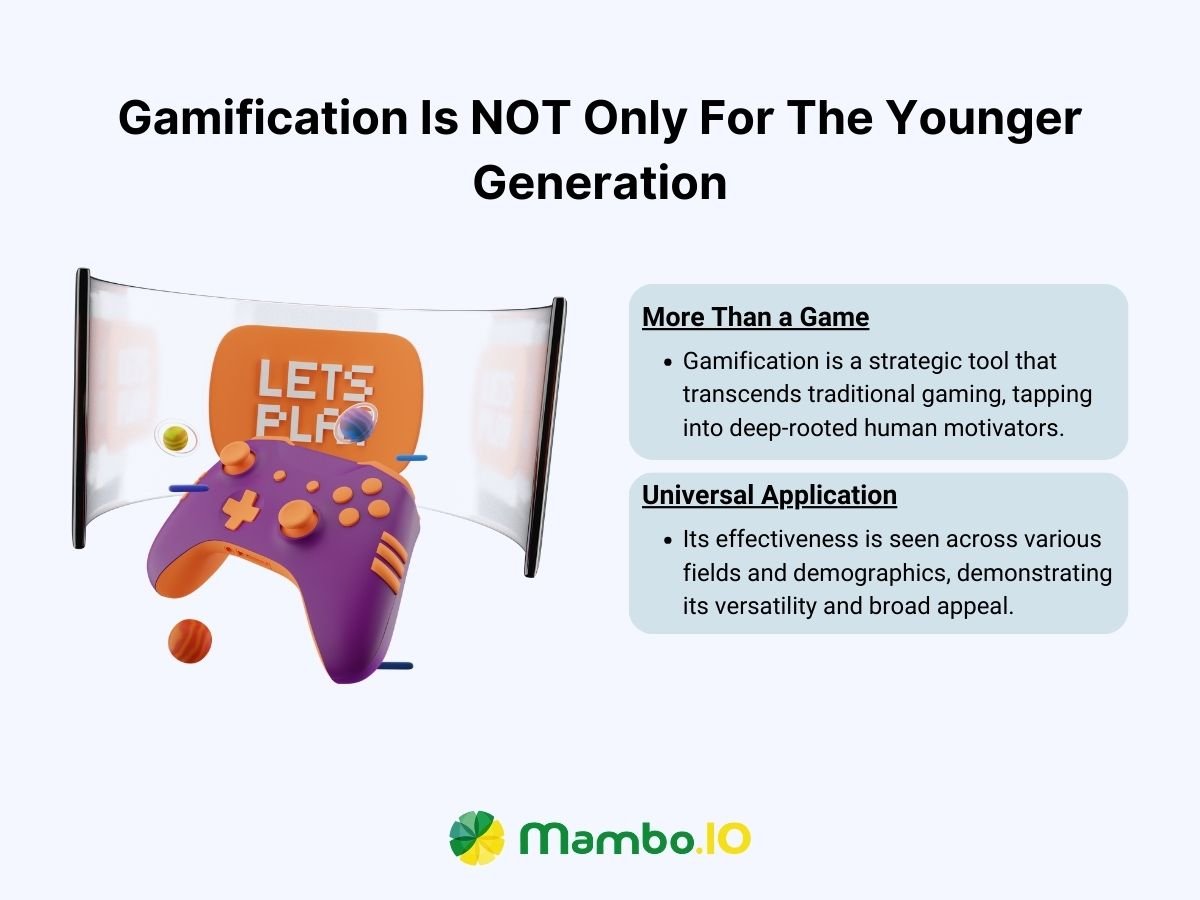
The older crowd can enjoy gamification too! It’s not just for people who grew up with a controller in their hands. Remember, gamification has a purpose – it’s not just frivolous fun.
So, before you say games just waste time, remember that gamification and video games are different. You can improve your workplace by using the interaction, competition, rewards and fun gamification offers. This is irrespective of what decade your teams were born in.
Gamification includes motivators for everyone at any age. We all want to feel excited, prepared, engaged, confident and of service to others during our working day.
And when we do well, we want that shouted about. Regardless of age, race, culture or gender – gamification triggers universal human motivators.
Maybe that’s why it’s present all over. From banking education, gamification is used to get business results by activating our need for progression, status, winning, achievement, rewards and competition.
#5. Gamification is not siloed to one industry
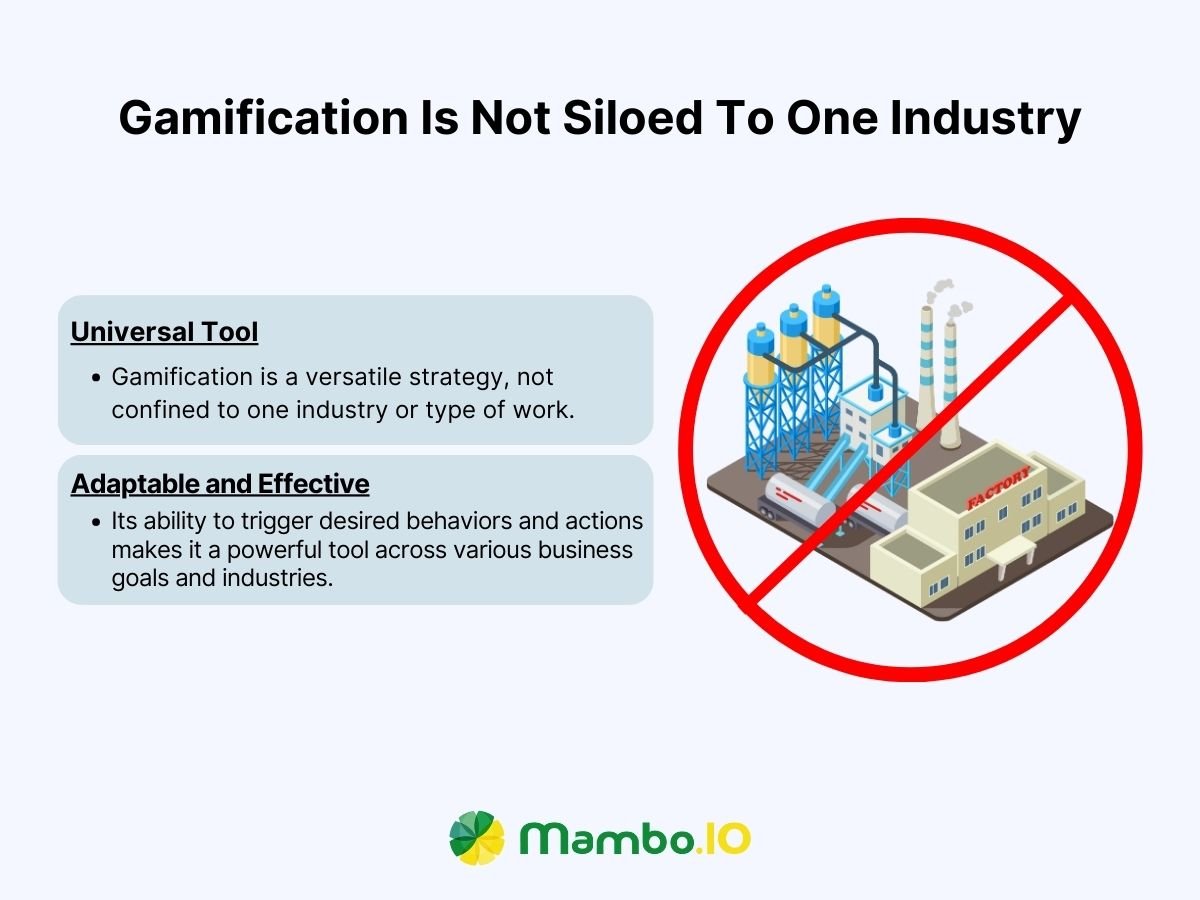
If you’ve come across gamification before, chances are it was in a learning app or LMS. But gamification is for every single facet of our working lives in every industry – not just education.
That’s because gamification triggers behaviours and actions. This could be anything from saving money to working out more. And when we use gamification at work, we improve performance by motivating and engaging our teams.
Once you see how well gamification works to improve KPIs in your contact centre or sales floor, you’ll look at marketing, support, finance and every other area. Where a goal exists, gamification can apply to make that metric move favourably.
Just because other industries are lagging behind early adopters, like education, doesn’t mean gamification won’t work just as well.
#6. Gamification is not a competition, it builds collaboration
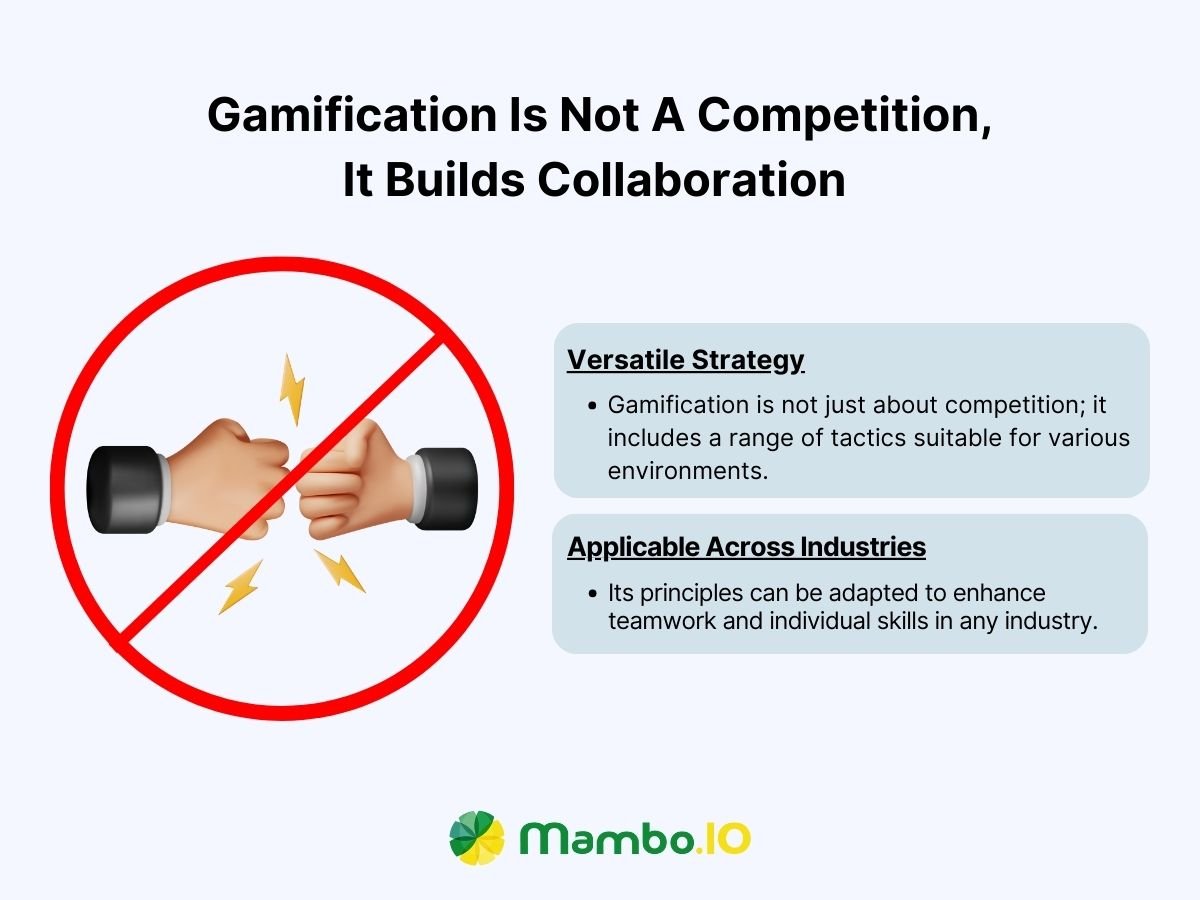
We’ve mentioned competition before, and it’s an easy one to fall back on. That’s because leaderboards and points are easier to quantify than other elements.
But you can’t overlook the soft behaviours. Think about skill building, innovation and teamwork. It’s more complicated to measure – yes, but just as valuable.
Remember, if you’re using a competition-only environment, that can demotivate people who see it as conflict. So, you need to use more motivators to build collaboration and positive team culture.
It’s a balancing game. You need to mix dynamics and mechanics to suit the needs of your team and reward social behaviours.
It’s possible to do this without any individual competition at all. In this instance, you’re dialling up the team-level achievements. So, don’t rely on just badges, points and leaderboards.
Pull in the softer side of gamification wherever it’s relevant to promote healthy working relationships. Combined, you’ll present the ideal mix of motivators for all team environments.
#7. Gamification is NOT for everyone
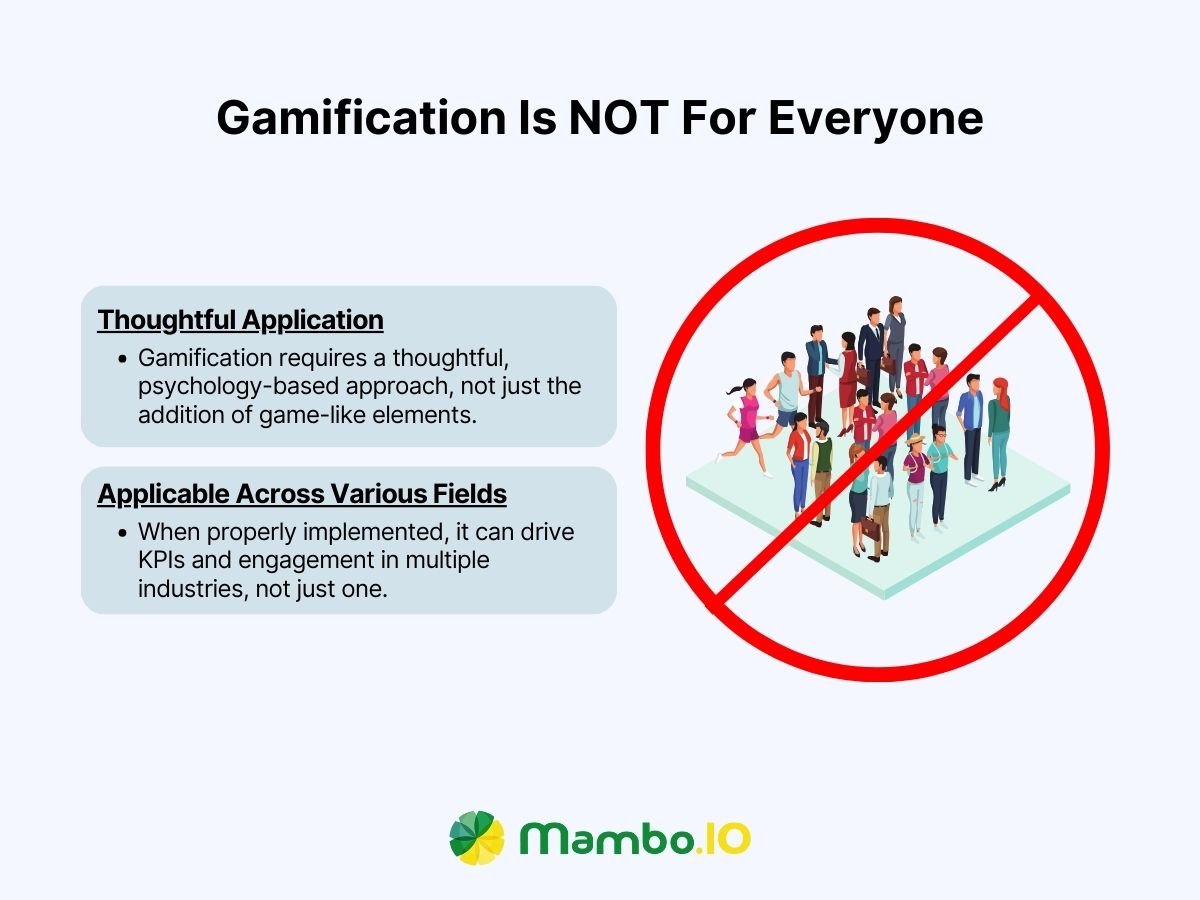
Gamification isn’t magic.
Sprinkling in rewards, leaderboards, and badges doesn’t fix your engagement issues. You need to underpin your gamification with the psychology of your users before you drop game mechanics on them. First, understand what triggers you need to place to reach the desired outcomes. That’s the science part.
We’ll go into neuroscience in more detail later. Just know that until you understand what people act FOR, implementing game elements doesn’t drive the KPIs you want. And an unfinished experience might turn off some of your users.
Look to have the whole picture in your mind before you scope your gamification intervention.
#8. Gamification is NOT sustained only using external rewards

Get too used to getting external rewards, and you might lose your internal motivations altogether.
Shockingly, if you rely on rewards like cash, praise and titles, you’re missing out on the soft levers like creating competition, demonstrating achievement or creating buzz.
We all want to make things happen. Easy wins just don’t feel as earned. We want to work towards our achievements in all successful gamification environments.
As we said before, just completing tasks and getting an external reward isn’t enough to maintain interest in the long run. Once you understand the science behind gamification, you’ll see what you need internal and external motivators to make it work.
So, dial down the cash incentives and dial up the praise & recognition to see even more return on your gamification projects.
#9. Gamification is NOT using heavy graphics to motivate users
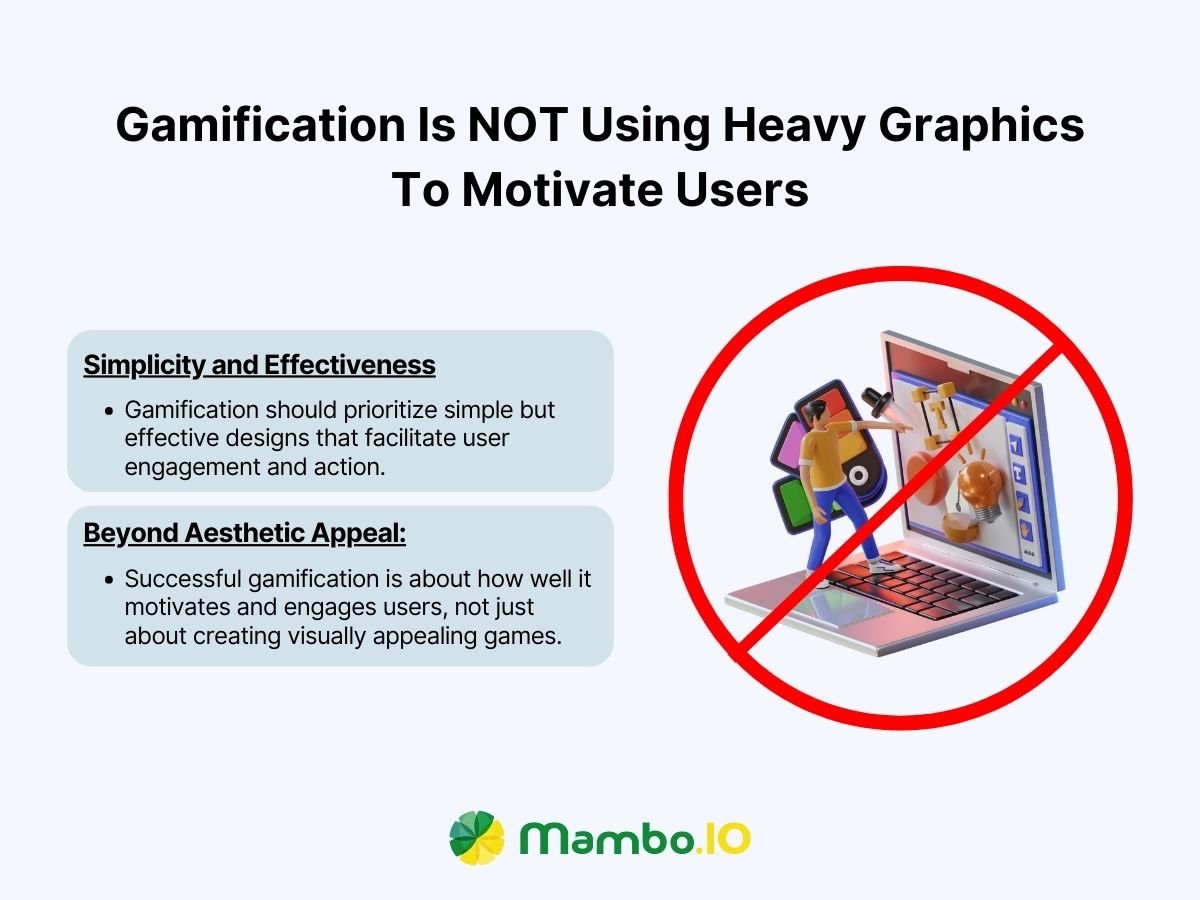
Sure, graphics do matter. Social triggers feed into avatars, teamwork and narratives. Task value relates to leaderboards, graphs and badges. Points can be differentiated visually and serve distinct purposes just by applying clever design. Lastly, how you deliver feedback and rewards matters too.
But you don’t need to go over the top. Huge, complex animations are fun, but not necessary to drive action. Worry less about how the unique game elements look and more about how well your users are responding and acting on your triggers. Just making a pretty game won’t generate the results you need.
#10. Gamification is NOT a temporary trend

Gamification isn’t going anywhere. It’s going everywhere. It’s spreading from HR to sales and growing at an exponential rate.
Plus, with mobiles in every hand, there are even more gamification routes not just for employees but for customer-facing applications too. We check our phones dozens of times daily, and it’s time to tap into that.
You can also look to be where your users are. Social networking integrations let you amplify your message as users share it with their circle.
Also, you can poll the audience faster than ever – even with a little one-question survey delivered via push. So, it’s easier than before to know what’s working and what isn’t. That lets you make adjustments on the fly for a long-lasting and valuable gamification project that drives measurable improvements to engagement, sales, and satisfaction.
While gamification is a new business concept, it’s not a new theory. Cereal boxes have contained toys since the mid-1900s. And sweepstakes, under-the-cap rewards and other gamification mechanics have been in place ever since. They’ve all had an impact on business outcomes -otherwise, they wouldn’t have lasted. But the first example of gamification is from 1980. Richard Bartle, a researcher and game designer created MUD1. It was the forefather of World of Warcraft and City of Heroes and is a great example of a text-based MMO. When it went live, it was called gamification but that term would evolve.
The next interaction was The Serious Games Initiative in 2002. Sectors like the military wanted to use real games as simulators for non-game scenarios. That’s the far end of the gamification spectrum because here you’re not just adding a game mechanic or two. You’re creating an actual video game under real-world conditions. And the military has been training soldiers in this way ever since. Around the same time, you have the social impact game movement. Games for Change used games to teach people about complex topics and show causality like within the Arab-Israel Conflict.
Modern gamification started to pop up in 2003. Conundra, a consulting firm for gamification, started courting brands. The goal was to apply gamification to consumer products like hardware. But it was probably too early. As such, it didn’t last long. However, the concept gained steam. Since 2005, there have been companies offering gamification as software. (That’s what we do here at Mambo, after all!) And in 2010, the movement hit its stride. Everyone seemed to agree on what gamification was and did after Jesse Schell spoke at the annual DICE conference.
He talked about the smart tech we see today like toothbrushes that track your time and routine. Then, he postulated about the future with web games on your cornflakes box, rewards for social sharing and government-backed sustainable mindset projects that give points for prescribed actions you can turn in for tax rebates. At times it got darker, like his talk about a REMtertainment system injecting adverts into your dreams. But regardless, this talk got people excited about gamification.
Additionally, Jane McGonigal’s book, Reality is Broken, also fueled the fire for gamification. In her TedTalk, she spoke about the power of games to enrich human society. They could help reverse climate change, poor health, inequality and more. But she doesn’t use the term gamification for this, because of the ‘folksy’ connotations. However, the core of the definition is there; using game mechanics to drive significant impact. And ever since, we’ve been evolving the ideas behind it. Today, the gamification industry is a multi-million-pound function that’s moving businesses forward in big ways.
Before we move on, we need to clarify the difference between serious games, game-based learning and actual gamification.
What are serious games?
Serious games are what they sound like. They’re meant to solve a problem instead of entertain. While they look like real video games like Call of Duty, they are designed to help you learn complex skills. Think military combat simulators or flight training programmes. The system looks like a video game but it teaches abilities. So, you’ll often find serious games in the sciences, military, healthcare and education.
Serious Games vs Gamification
Both gamification and serious games fuel action and can create a learning environment. However, serious games are complete video games. Gamification just puts game elements into a non-game environment to make it more engaging.
Best serious games examples
You’ve probably played this game. It’s the most popular flight simulator of all time and represents a real civil aviation situation in a non-combative environment. While basic by today’s standard, this title is still a popular example of the simulator genre.
#2. Where in the world is Carmen Sandiego (1985)
Learn geography with the catchiest theme tune of all time in 1985 video game precursor to the popular 1990s TV show. Track villains around the globe as a slick detective and put them to justice all while learning about the cities you visit.
#3. DragonBox (2012)
With fun mini-games, learn your numbers, multiplication, algebra, chess and more. This platform contains more than 30 out-of-the-box teachable lesson plans to supplement the game apps for each subject. It’s great for educators and parents.
#4.Tiltfactor laboratory (2003)
This game studio uses a range of games to create social change. They combine psychological triggers with fun gameplay to combat stereotypes, promote wellness and encourage other healthy behaviours. They’re encouraging socially-conscious conversations.
#5. A force more powerful (2006)
This game, created after a documentary about non-violent resistance was developed with the help of Serbia’s Otpor! Movement. It teaches nonviolent methods for waging conflict across a range of scenarios built by the users.
#6. Darfur is dying (2006)
Within a year, this game saw over 800k active players. One of the most explosive news games of all time, it helped people learn about the humanitarian disaster by exposing them to the truth of the Darfur conflict. As a result, the plight of the Darfur people was brought to the forefront.
A game looking for a peaceful resolution to the Israeli-Palestine conflict, this government simulator sees players pick a side. They then make all the same social, political and military decisions that real leaders do while exploring the consequences of each choice.
#8. World without oil (2007)
This worst-case-scenario game lets you see how the oil crisis might affect you. It uses alternate reality simulation to let you “Play it – before you live it.” The game features 1,500 blogs, messages, images and videos to drive its message home.
#9. FoldIt (2008)
This game got real press. Here, users collaborate to solve puzzles for science. It’s famous for unlocking the structure of the Mason-Pfizer monkey virus in only 10 days. Before this, the solution had eluded science for 15 years. As such, it’s often a case study for serious games.
#10. IBM city one (2010)
Similar to SimCity from the early days of video games, IBM City One is a city planning tool. It helps you understand how a municipality runs and the causality between decisions on water, electricity and the like. How will your city fare?
#11. Amnesty the game (2011)
Ever wanted to be a Special Amnesty International Agent? With this game, you can! Your mission is to abolish the death penalty and you need to convince people and their governments that this is the right call. Can you complete your mission?
#12. Ludwig (2012)
Ready to change the world by tapping into renewable energy sources? In this game, you’re a little robot travelling through the realms of water, sun, wind and combustion. You’ll learn about each type of energy and collect rewards as you progress.
#13. CodinGame (2012)
CodinGame is a coding community that lets you play fun games to help you practise your coding skills. One of the most popular games is called Clash of Code. It’s a serious game designed to improve your code and problem-solving skills.
#14. Superbetter (2012)
Remember that gamification guru from before, Jane McGonigal? Well, she created a serious game following a concussion she suffered in 2009. What started as Jane the Concussion-Slayer was renamed ‘Superbetter’ and it helps people achieve their goals and overcome challenges.
#15. CodeCombat (2013)
This powerful piece of EdTech is designed for teachers and students but is open to all. With this serious game, learn to code in Java, Python and more. You’ll start by moving your avatar around by utilising basic code and work your way through exciting levels -learning as you go.
#16. CodeMonkey (2014)
With CodeMonkey, use CoffeeScript to make games in HTML5. (Yes, that’s a real coding language!) While this game is designed for children, it’s accessible to all ages and builds confidence in one’s coding ability. This is all while being more fun than a dusty textbook.
#17. Pacific: the leadership game (2015)
Do you want to be a powerful and successful people leader? This serious game was built using the knowledge of over 200 execs and CEOs. Survive on a deserted island and lead your group to safety. You’ll need delegation, communication, coaching and more to make it out.
#18. Sea hero quest (2017)
This game from Deutsche Telekom Alzheimer’s Research UK’ and Glitchers studio works to collect dementia research data. As you sail a canal boat, the app tracks your navigational skills. If they see those skills start to droop, that can be a sign of dementia.
#19. Minecraft education edition (2018)
The most popular video game ever, Minecraft has sold 238m+ copies of its engaging sandbox game. But it’s not just for entertainment. The game has an education mode which helps to enhance STEM skills and increase problem-solving abilities in tandem with educators.
#20. Bleached Az (2019)
This game is all about protecting the coral reefs from pollution and overfishing. It’s driving awareness of environmental conservation and educating users on why it’s important to save our environment. Plus, 20% of profits go towards planting trees to scrub CO2.
#21. EndeavorRx (2020)
Fight ADHD in kids aged 8-12. This game is PRESCRIBED in America to treat ADHD by doctors following FDA approval. It targets the attention-maintaining parts of the brain to increase its ability to focus. As a result, symptoms are reduced and the condition is more manageable.
#22. PandemiQuest
This game is based in Toronto and helps to ease concerns around COVID. During the game, battle COVID with proven PPC and germ eradication methods.
#23. Reducept (2020)
Developed with a medical psychologist and health scientist, this game helps treat patients living with chronic pain. It drives awareness of where the pain is originating and uses VR to help give patients more psychological control over their condition.
#24. Working with water (2020)
Creating and maintaining a clean water supply is challenging for Australia’s central coast. This game helps players understand population growth, sustainability and demand as they build water management services to meet the community’s needs. How will you do?
What is game-based learning?
Game-based learning (GBL) is all about education-focused games. Also called DGBL (Digital Game-Based Learning), these games teach attitudes, knowledge and skills. This expanded toolkit comes from either making a game or playing one. Overall, these learning environments contain games designed for educational environments or used in an educational environment. The challenge of any non-AAA game is budget. And making a game-based learning intervention is difficult because it requires both good learning and effective game elements.
However, it’s easy to conflate GBL with a serious game. However, GBL is a methodology that serious games can exist within as a product. These interventions are made by instructors for the classroom and are tied to learning KPIs. When considering these concepts, serious games sit inside GBL, and GBL is a bigger idea.
Serious Games vs Game-Based Learning vs Gamification
Game-based learning (GBL) exists whenever you use games to learn. Serious games are games designed for that purpose – to teach a skill, change attitudes or give knowledge. And gamification is using game elements to create action in a non-game environment. This might be learning but it also could be for productivity, sales, enrichment and more.
From its emergence in 2003, gamification has become ubiquitous. From education to financial services, gamification is making a deep impact on core KPIs. So, management teams are embracing the approach in 2022 and beyond. Gamification as a market is expected to reach $58.8 billion by 2028, rising at a market growth of 26.8% CAGR during the forecast period.
Smartphones have a lot to do with this trajectory. It makes the technology more accessible across all parts of our lives – as consumers and employees. But, in general, more senior leaders understand the value of gamification in changing human behaviour and are turning to it to drive innovation.
Furthermore, the global pandemic increased our reliance on screens and virtual connectivity. Those in the sales and event fields needed to fundamentally shift how they did business. However, at the same time, the challenge of enticing and building relationships became greater than ever before. And gamification was brought in to bridge the gap where in-person functions once stood.
Now, gamification forms a core part of many web and mobile apps, intranets, CRM, LMS, e-commerce, e-learning and more. They improve app engagement statistics by making the product more “sticky” and providing a much-needed sense of achievement. Perhaps that’s why it’s now a part of nearly every industry on the planet.
Everyone is using gamification. From multinationals to startup operations, influencing KPIs and increasing engagement can’t be overlooked. Naturally, enterprise organisations have the most significant market share in gamification when viewed by sheer dollar value. That’s because they were on the cutting edge with early adoption at big names like Google, HP and Oracle. Additionally, since they have large workforces, they represent a larger overall cost as a share of the pie. Plus, most of this is cloud-based. These organisations are already largely untethered, making the adoption of gamification even easier.
However, SMEs are expected to catch up. Competition with startups who are digital natives will spur many engagement-focused programmes among mid-sized operations. They’ll look to benefit from the inroads startups are making with gamification-enhanced hiring, game-boosted customer satisfaction efforts and the like.
Where the early inroads were made, gamification is nearing maturity. This means retail and education are nearly fully saturated. Retail sits at a 28.6% market share, with education close behind. But we expect financial services, e-commerce, government and healthcare to grow rapidly over the coming years as top voices in these sectors continue to champion gamification.
Who is using more gamification? (by industry)
As we mentioned before, retail and education are approaching maturity. But following those two sectors are banking, government, healthcare, IT & telecom, and then the rest of the marketplace. These 6 sectors represent the largest inroads for gamification as the current market sits. However, as we’ve seen over the last 2-3 years, external forces can disrupt this movement and can cause challenger industries to come from behind.
Who is using more gamification? (by region)
Unsurprisingly, North America will dominate the global market share for gamification adoption. This is mainly due to the market’s maturity and developed comms infrastructure. There’s also a deep undercurrent of comfort with online gaming that’s transitioning to corporate environments.
Customer-centric operations like Salesforce, Oracle and Cisco are driving this growth alongside the complete internet domination present in the US and Canada. This familiarity with online solutions will increase gamification rollout, and NBC, eBay, Adobe and Walgreens are already working on projects in this space.
But Europe won’t be left behind. The UK, France and Germany are talking about gamification at national conferences, and Spain is gaining traction in this space as well. Most of the applications are in healthcare and retail, focusing on CX, sales and employee engagement. It’s possible this boost in adoption may be due to strict lockdown policies over the last few years. There’s likely an appetite to claw back depressed profits in most sectors.
However, the real growth figures will come from Asia regarding new market players. India and China will look to improve UX along with ease of use, and South Korea’s boom in SMEs will fuel more entrants. Look for memberships and reward points to dominate the loyalty markets and projects of this type to fuel demand.
MEA and Latin America are still growth opportunities, with more local and regional suppliers sprouting daily. Particularly look to Latin America. With government involvement to boost startups and innovation, we’re seeing a rise in e-learning and game-based education. This is most notable in Brazil.
While rapidly growing, this tech is still in its infancy. Gamification is the solution of choice for engagement and problem-solving.
Technology is just opening up new avenues every day. Think about what the widespread adoption of AR/VR, ML, laser scans, bio tracking, head-mounted displays and 3D will have on gamification. It’s where the investment and innovation are being funnelled. And we’re seeing more and more VR headsets marketed towards the home and office for applications like the Metaverse.
Plus, big multinationals are counting on these advancements to fuel more retail consumption from a global market. VR allows for better home shopping experiences with virtual try-ons and showrooms are ripe for gamification. These solutions will also better protect their bottom line should more lockdowns be initiated in the future.
Lastly, the Metaverse and other virtual spaces full of gamification can move opinions and enhance our environment and economic conditions. You’ll be able to learn, grow and interact both in the real world and online across time zones and in ways you would have never thought possible.
Artificial intelligence in gamification
We’re seeing more and more AI paired with gamification too. Take the P&G gamified recruitment tool, for instance. Here, applicants received assessment tests that dynamically adjusted based on their performance. This more candidate-centred experience boosted positive recruitment outcomes by 300%.
But it doesn’t stop with recruitment. These AI-based gamified systems are improving onboarding and training as well. The AI can feed learning teams real-time insights to allow them to serve customised training modules around their learning needs. The new systems can even deliver this training in a routine and automated manner. Instead of L&D teams manually triggering coursework, AI can send the next most appropriate course to learners as part of a workflow.
However, this is just the surface of where this AI-based gamification can go. As the technology underpinning it gets smarter, the applications and benefits will increase.
IoT plus gamification
Now, devices can talk to our gamified elements, too. This is leading to more immersive interventions. IoT uses big data from environmental and sensory inputs to enhance machine learning, AI and predictions. This could mean tracking heart rate, eye movement, breath and more. When the game reacts to you and is personalised better, you’re more likely to interact with it, right?
In addition, you’ll find the environment it creates to be a more immersive one. Just think about how Microsoft has already used this technology to make 3D virtual stages for keynote speakers. With Azure Kinect sensors and mapping tech, it creates a virtual playground. And this isn’t the only way IoT and gamification will work together to enhance gamification adoption.
Blockchain for rewards & transparency
Crypocurries seem here to stay, and they’re starting to empower the world’s gamification projects. This is especially so with loyalty programmes like the one by Singapore Airlines. Instead of exchanging for cash, users can now get digital tokens secured with blockchain technology. The applications for this are endless. Imagine exchanging your XP points for Ethereum or your Badges for Bitcoin. It’s proving to be a popular option.
Plus, it’s probably more secure too. On gamified apps and LMS systems, blockchain-managed wallets can be adapted to hold reward points more securely than on a local or cloud-based server. It also increases the data security and portability of these gamified assets, which we know users want. By satisfying their currency, safety and privacy needs, you can fuel more engagement via gamification.
Gamification & the virtual
You’ve already started to see the path being forged. Fortnite broke new ground with international virtual concerts and brand collaborations. But online, people have been arranging large-scale virtual gatherings for at least as long as World of Warcraft servers have been up. We’ll likely see more behavioural changes with head-mounted displays and physical integrations.
We already know gamification increases the pace and quality of learning. But with VR and other virtual spaces, how people interact and think can change too. This will lead to faster and more robust levels of influence. Users will see what’s working for others in this 3D environment and apply it themselves. Consider how this can improve compliance and safety training adoption – amongst many other applications.
